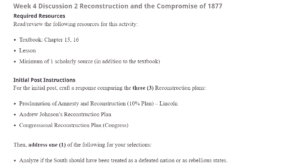Reconstruction Plans
Craft a response comparing the three (3) Reconstruction plans:
The Proclamation of Amnesty and Reconstruction addressed three areas. First, it allowed complete property restoration and pardon to all persons involved in the rebellion. However, the highest officials of the Confederate, as well as military leaders, were exempted from the said pardon. Secondly, a new state government would be created if 10% of the eligible voter took an oath of allegiance to the U.S. Thirdly, states from the South that were allowed to join the U.S. were expected to put into place plans that dealt with slaves that were freed without compromising the said freedom (OpenStax, 2019).
Would you like to have an unpublished version of “Reconstruction Plans”? Reach out to us.
President Johnson was not satisfied with Andrew’s reconstruction strategy, and as soon as he was sworn in, he came up with his modified plan. The reconstruction plan included the high-ranking and wealthy Confederate officials and white Southerners to personally petition the President for pardon. In addition, a Southern state that wanted to be included in the U.S. was expected to ratify the 13th Constitutional Amendment. The ratification called for the complete abolishment of the slave trade and repudiation of the Confederate war. All the Confederate states had met the stipulated conditions by 1865 and thus joined the United States (OpenStax, 2019).
In the following year, 1866, Congressional Republicans were vexed by the mass killing of former slaves and the adoption of restrictive black codes. The Republicans took over Johnson’s Reconstruction plan and denied Congressional seats to the former Confederate States. The Republicans also passed the 1866 Civil Rights Act. They also wrote the Constitution’s 14th Amendment. This Amendment gave extended African Americans citizenship rights and minimized congressional representation of any former Confederate state that denied African Americans the right to vote. The 15th Amendment was ratified in 1870, allowing Black men the right to vote (OpenStax, 2019).
Analyze the impact of the Compromise of 1877 that ended Reconstruction on African-Americans.
The Reconstruction policies were beginning to lose support. These policies were set up to protect African American rights and, more so, those that lived in the Southern states (Randall & Donald, 2016). The Reconstruction laws and Amendments were from 1873, limited by decisions made by the Supreme Court. These decisions affected the 14th and 15th Amendments as these legislations offered Blacks constitutional protection, the right to vote, and citizenship status rights.
After the 1876 presidential election, marred with violence and corruption, an Inquiry Commission was set up to resolve the issue of differing vote counts between the Republicans and the Democrats. Republican Rutherford Hayes, at this time, met with his allies and moderate Democrats and convinced them to accept the controversial results through a filibuster. In February, following a meeting with the Democrats, the latter agreed on a Hayes’ victory and to respect African Americans’ political and civil rights. This agreement was based on the condition that federal troops would be withdrawn from Southern states. This step consolidated the control that the Democrats had on the Southern region. In addition, Hayes would have to agree to have a leading Southerner in his cabinet and support federal aid for the Pacific Railroad and Texas. On March 2nd, all the disputed votes were awarded to Hayes following a congressional vote of 8-7 (OpenStax, 2019).
Hayes proceeded to appoint David Key of Tennessee as the Post Master General. However, he failed to follow his promise regarding the Pacific Railroad and Texas. In two months, Hayes withdrew troops from South Carolina and Louisiana and allowed for the complete takeover by the Democrats over these states. Federal power was now restored to the Democrats.
The Democrats failed to keep their promise to respect the political and civil rights of the blacks. The federal interference with the affairs of Southern states led to African American voters’ disenfranchisement. Laws that separated the Blacks from the Whites were passed in the Southern states. These segregating laws governed the South until the rise of the 1960s civil rights movement. Thus, the Compromise of 1877 ended the Reconstruction era.
Similar Post: MBA Reflection
References
OpenStax. (2019). U.S. history. OpenStax CNX. Retrieved from https://cnx.org/contents/[email protected]:gMXC1GEM@7/Introduction
Randall, J. G., & Donald, D. (2016). The Civil War and Reconstruction. Pickle Partners Publishing.
ORDER A PLAGIARISM-FREE PAPER HERE
We’ll write everything from scratch
Question
Week 4 Discussion 2 Reconstruction and the Compromise of 1877
Required Resources

Reconstruction Plans
Read/review the following resources for this activity:
- Textbook: Chapter 15, 16
- Lesson
- Minimum of 1 scholarly source (in addition to the textbook)
Initial Post Instructions
For the initial post, craft a response comparing the three (3) Reconstruction plans:
- Proclamation of Amnesty and Reconstruction (10% Plan) – Lincoln
- Andrew Johnson’s Reconstruction Plan
- Congressional Reconstruction Plan (Congress)
Then, address one (1) of the following for your selections:
- Analyze if the South should have been treated as a defeated nation or as rebellious states.
- Explain how the American culture and society changed in the North versus the South during Reconstruction.
- Analyze the impact of the Compromise of 1877 that ended Reconstruction on African-Americans.
Follow-Up Posts
Compare your selections and analysis of selections with those of your peers. If they chose different events, examine how yours are similar and/or different. If they chose the same events, build on their posts by providing additional information about the events that you have not already noted in your own post.
Writing Requirements
- Minimum of 3 posts (1 initial & 2 follow-up)
- APA format for in-text citations and list of references
Grading
This activity will be graded using the Discussion Grading Rubric. Please review the following link:
- Link (webpage): Discussion Guidelines
Course Outcomes (CO): 1, 2, 3, 4
Due Date for Initial Post: By 11:59 p.m. MT on Wednesday
Due Date for Follow-Up Posts: By 11:59 p.m. MT on Sunday

